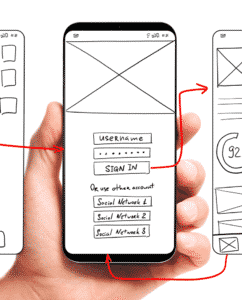
Enterprise UX Design: Tips to Overcome Complexity
For many, the mere mention of enterprise software conjures images of confusing settings and bland, cluttered interfaces. While there may be some truth to this stereotype, enterprise software has made big strides, recently, on the user experience front. There has been a growing realization that UX (User Experience) design principles, which have been applied to consumer products for years, are also valuable in an enterprise environment.
A common goal of UX design is reducing or managing complexity for the user. However, managing complexity seems at odds with very nature of an enterprise product. How can we apply UX design principles in this situation? The UI/UX team at TalentQuest has found, through experience, a few approaches that work.
Don’t always rely on user training to solve complexity. Make sure UX design principles inform everything you build.
Some training and onboarding are often a necessity with enterprise software, but it shouldn’t become a crutch in the design process. A few key principles of UX design have proven particularly useful for our team in dealing with complexity. These principles reduce cognitive load for the user and help to lessen the need for ongoing support:

Make elements discoverable: Does the interface offer visual cues that give the user an idea of what is possible? Even if the user can’t immediately figure things out, as is common in enterprise interfaces, the application needs to offer the user a chance to explore and eventually understand how things work.
Prevent errors and display system status: Does the interface prevent errors that can’t be undone and clearly explain its current state? Error prevention offers users a sense of security by providing them with a safety net. In a complex system, this is of critical importance.
Reference consumer product design patterns when appropriate.
The interfaces of popular, frequently used apps become like familiar faces we all recognize and feel comfortable with. Referencing these popular design patterns can make it easier to get usability wins at the enterprise level. When we began the design work on TQ Connect (Our module that enables feedback, recognition, and check-ins), the goal was to simplify the interface and have it resemble elements from chat and social media applications, as there was some conceptual overlap. Is TQ Connect more complex than some consumer products? Most definitely. However, the immediate visual familiarity and relatively simple interface help to engage the end user and provide a sense of control.
Stay focused on user personas and roles, not features and functions.
User personas are ideal for understanding your users. However, they can be difficult to build and maintain at the enterprise level, as an application’s market might span across many industries and user types. If you don’t have personas developed, don’t ignore the value of considering the user roles in your system in helping to guide your design work. Analyzing one user role at a time when designing is a good way to reduce complexity. Instead of working to meet a list of lengthy requirements, you’re instead designing with a user’s needs and goals in mind, while removing what isn’t necessary. TQ Performance Management provides a good example. First we focused on simplifying the experience for the end user with the objective of making it highly intuitive for even a novice and only then began to build complexity for more advanced user roles when needed.
Don’t underestimate the value of visual design.
Visual design is sometimes mistakenly perceived as purely decorative in the enterprise world. Despite this, it can definitely have functional value in solving challenges with design complexity. Sometimes you can’t avoid displaying a lot of data and information on a page at once. The home page of our talent management system is a good example as it displays tasks, goals, team metrics, insights, and upcoming events. Strong visual design can help to solve complexity issues by compartmentalizing related information, bringing emphasis to the most important data, and enhancing visual hierarchy to direct the user’s eyes as they scan the page.
Pioneering UX researcher Don Norman once said, “Forget the complaints against complexity; instead, complain about confusion.” This statement is particularly relevant in the enterprise space as we’ll likely never eliminate complexity. However, reducing perceived complexity and user confusion are within our reach if we consider a user-centric approach throughout the design process.
